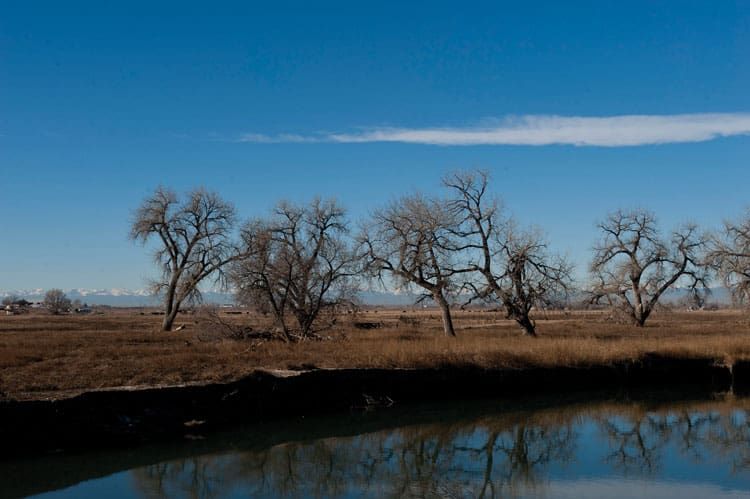Colorado ag lands yield growing value

Colorado cropland soared 22 percent in value to $1,780 per acre in 2013, well above the national rate, as high crop prices and long-term prospects for food production lured venture capitalists and other investors to the agricultural land market.
Nationwide cropland values surged 13 percent in 2013, according to the National Agricultural Statistics Service.
By a broader measure, Colorado’s farm real estate climbed 68 percent in value in the last decade, reaching $1,280 per acre in 2013, up from $760 per acre in 2004. Farm real estate includes cropland as well as pasture and other kinds of agricultural property. During that same period, national farm real estate values have more than doubled, rising to about $2,900 per acre in 2013, up from $1,300 per acre in 2004.
Ed Orr, who sells farm and ranch land as owner of Orr Land Co. in Greeley, said continued low land inventory and high demand would put increasing pressure on land sales prices.
Meanwhile, investors have flocked to farm land in Northern Colorado, experts say. Real estate investors generally have bought and held farm land without seeking to change its use for development.
“Farm ground continues to have some attractiveness as far as long-term investment,” Orr said.
Higher crop prices have helped boost land values, said Stephen Koontz, Colorado State University associate professor and extension economist. During the drought in 2012, corn surged to $8 a bushel on the Chicago Mercantile Exchange. Corn futures since have fallen to slightly more than $4, which may mean a drop in rent prices for farm ground, but not sales prices, Koontz said.
Lower crop prices may at least lead to lower rents, Koontz said.
“Some of that corn ground is going to be way too high priced, given where the market is now,” he said. “I would expect to see some hard discussions between landlords and renters about what they’re paying for cash rent per acre for corn ground or wheat ground.”
Along with increased farm revenue, Doug Claussen, a certified public accountant with Kennedy and Coe LLC in Loveland, said companies that have enjoyed increased profits have been willing to buy land at higher prices in the past few years. That has contributed to the increased land values.
However, Claussen, an agribusiness specialist, believes that farm land values will continue to climb, but at a slower rate.
“It doesn’t appear that (growth rate) can continue for the foreseeable future,” he said.
Meanwhile, investors interested in farmland have included private equity firms, hedge funds and university endowments, according to a 2012 report from the Oakland Institute, a policy think tank in Oakland, Calif.
According to 2012 estimates from the International Institute for Environment and Development, 190 private equity firms invested in agriculture and farmland. Investors own an estimated 1 percent of farmland nationwide, said Anuradha Mittal, executive director of the Oakland Institute.
“The financial sector is taking a very active interest in farmland as never seen before,” she said. “They’re all very eager to capitalize on this farmland.”
A number of factors have driven investment, Mittal said, including population growth, food price increases, water shortages, speculation and increased interest in natural assets among investors. Investors also have sought profits from renting high-value land to farmers.
High land prices driven partly by real estate investment pose a barrier for farmers and ranchers wanting to start in the industry, she added.
The investors also include farmers themselves after raking in profits from lucrative corn crops.
“It isn’t just the speculators,” Koontz said. “It’s your neighbors that are buying some of that ground and looking for income.”
High land prices may cause sticker shock for young farmers and have become an increasing problem in recent years, Koontz said. But many young farmers start with equipment and land owned by their parents because the costs of starting new in the business are too high and the challenges posed by newcomers’ inexperience too great.
“More than ever in my career, I’ve seen kids out of college going back to the farm and ranch,” he said. “They’re not going and buying an operation, but becoming part of it and then working their way into it.”
Colorado cropland soared 22 percent in value to $1,780 per acre in 2013, well above the national rate, as high crop prices and long-term prospects for food production lured venture capitalists and other investors to the agricultural land market.
Nationwide cropland values surged 13 percent in 2013, according to the National Agricultural Statistics Service.
By a broader measure, Colorado’s farm real estate climbed 68 percent in value in the last decade, reaching $1,280 per acre in 2013, up from $760 per acre in 2004. Farm real estate includes cropland as well as pasture and other kinds…
THIS ARTICLE IS FOR SUBSCRIBERS ONLY
SPONSORED CONTENT
Exploring & expressing grief
Support groups and events, as well as creative therapies and professional counseling, are all ways in which Pathways supports individuals dealing with grief and loss.
Continue reading for less than $3 per week!
Get a month of award-winning local business news, trends and insights
Access award-winning content today!

